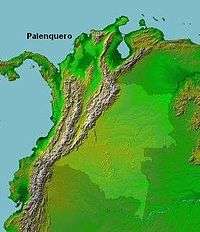Spanish-based creole languages
A number of creole languages are based on the Spanish language.
Spanish creole languages
Chavacano
Chavacano (also Chabacano) is a Spanish-based creole language and the name of six Spanish dialects that became a creole language spoken in the Philippines. The name of the language stems from the Spanish word Chabacano which means "tasteless", "common", or "vulgar".[1] In Mexico "chabacano" means "apricot" (a fruit).
Dialects of Chavacano are spoken in Cavite City and Ternate (both on Luzon); Zamboanga, Cotabato and Davao (on Mindanao), Isabela City and other parts of Province of Basilan and elsewhere. According to a 2007 census, there are 2,502,185 speakers in the Philippines. It is the major language of Zamboanga City. Chavacano is also spoken in Cavite City and in parts of Ternate, Cavite and Sabah, Malaysia nearest to the Philippines, and even in Brunei and Latin America, because of recent migrations.
Most of the vocabulary comes from Spanish, while the grammar is mostly based on the Austronesian structure. It is used in primary education, television, and radio. Recently English words have been infiltrating the language.
For more information see the article on Chavacano, or the Ethnologue Report on Chavacano.[2]
Palenquero

Palenquero (also Palenque) is a Spanish-based creole spoken in Colombia.
The ethnic group which speaks this creole consisted only of 2,500 people in 1989.
It is spoken in Colombia, in the village of San Basilio de Palenque which is south and east of Cartagena, and in some neighborhoods of Barranquilla.
The village was founded by fugitive slaves (Maroons) and Native Americans. Since many slaves had been only slightly exposed to contact with white people, the palenqueros spoke creole languages derived from Spanish and from their ancestral African languages.
Spanish speakers are unable to understand Palenquero. There is some influence from the Kongo of the Democratic Republic of Congo. In 1998, only 10% of the population younger than 25 spoke Palenquero. It is most commonly spoken by the elderly.
For more information see the Ethnologue Report on Palenquero.[3]
Bozal Spanish
Bozal Spanish is a possible extinct Spanish-based creole language that may have been a mixture of Spanish and Congolese, with Portuguese influences.[4] Attestation is insufficient to indicate whether Bozal Spanish was ever a single, coherent or stable language, or if the term merely referred to any idiolect of Spanish that included African elements.
Bozal Spanish was spoken by African slaves in Cuba[4] and other areas of South and Central America from the 17th century up until its possible extinction at around 1850.[5]
Spanish-influenced creole languages
Annobonese
The Annobonese language is spoken by 9,000 people on the islands of Ano Bom and Bioko, in Equatorial Guinea. It is locally called Fa d'Ambö (Fa d'Ambu or even Fá d'Ambô). It is a Portuguese-based creole, similar to Forro, with some borrowings from Spanish. In fact, Fa d'Ambu is derived from Forro as it shares the same structure (82% of lexicon). In the 15th century, the island was uninhabited and discovered by Portugal but, by the 18th century, Portugal exchanged it and some other territories in Africa for Uruguay with Spain. Spain wanted to get territory in Africa, and Portugal wanted to enlarge even more the territory that they saw as the "New Portugal" (Brazil). Nevertheless, the populace of Ano Bom was against the shift and was hostile toward the Spaniards. This hostility, combined with their isolation from mainland Equatorial Guinea and their proximity to São Tomé and Príncipe—just 400 km from the island—has assured the maintenance of its identity.
Fa d'Ambu has gained some words of Spanish origin (10% of lexicon), but some words are dubious in origin because Spanish and Portuguese are closely related languages.
Papiamento
Papiamento or Papiamentu is a creole language spoken by 359,000 people.
Primarily spoken in Curaçao and Bonaire by 179,000 people in 1998 and Aruba by 100,000 people in 2004.
Because of the similarities between these Iberian languages, it is difficult to ascertain whether a certain feature is derived from Portuguese, Spanish or Ladino, after the adaptation to Papiamento rules.
For more information see the Ethnologue Report on Papiamentu.[6]
Pichinglis
Pichinglis is spoken on Bioko island, Equatorial Guinea. It originated with the arrival of Krio speakers from the mainland. Krio is a creole that derives most of its vocabulary from English, but the Spanish colonization of Guinea exerted Spanish influence on its lexicon and grammar.
San Andrés–Providencia Creole
San Andrés–Providencia Creole is one of the main languages of the Archipelago of San Andrés, Providencia and Santa Catalina, Colombia (alongside Spanish and English) which uses expression and words from English (73%), Spanish (17%) and African languages.
See also
- Judaeo-Spanish, also known as "Ladino", which diverged from Old Spanish
- Pidgin
- Real Academia Española
- Linguistics
- Spanglish
References
- For a discussion about the origins of Papiamentu, see "Papiamentu facts",[7] an essay by Attila Narin.
Notes
- ↑ "Chabacano | Spanish-English dictionary". EUdict. Retrieved 2015-10-08.
- ↑ "Chavacano". Ethnologue. 1999-02-19. Retrieved 2015-10-08.
- ↑ "Palenquero". Ethnologue. 1999-02-19. Retrieved 2015-10-08.
- 1 2 Clements, J. Clancy. "Bozal Spanish of Cuba", The Linguistic Legacy of Spanish and Portuguese, Cambridge University Press, 2009. 9780511576171
- ↑ Lipski, John M. "Where and how does bozal Spanish survive?", Spanish in Contact: Policy, Social and Linguistic Inquiries, John Benjamins Publishing Co., 2007.
- ↑ "Papiamentu". Ethnologue. 1999-02-19. Retrieved 2015-10-08.
- ↑ "Papiamentu - Papiamento". Narin.com. 1999-04-07. Retrieved 2015-10-08.
External links
- Spanish-based creole languages at DMOZ
- Real Academia Española
- Association for Portuguese and Spanish Lexically Based Creoles (ACBLPE)